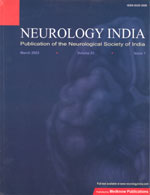
|
Neurology India
Medknow Publications on behalf of the Neurological Society of India
ISSN: 0028-3886
EISSN: 0028-3886
Vol. 55, No. 2, 2007, pp. 136-140
|
 Bioline Code: ni07050
Bioline Code: ni07050
Full paper language: English
Document type: Research Article
Document available free of charge
|
|
|
Neurology India, Vol. 55, No. 2, 2007, pp. 136-140
| en |
New-onset acute symptomatic seizure in a neurological intensive care unit
Narayanan, Jaishree T & Murthy, JMK
Abstract
Objective: New-onset acute symptomatic seizures can be the presenting feature of acute neurological diseases. The etiological spectrum of new-onset acute symptomatic seizures and outcome may be different in developing countries when compared to developed countries.
Aim: To study the clinical profile of new-onset acute symptomatic seizures as the first presenting event in patients with acute neurological illness in a neurological intensive care unit (NICU) in a developing country.
Settings and Design: Prospective study in a NICU in a tertiary care hospital.
Materials and Methods: Consecutive patients with acute symptomatic new-onset seizure admitted to NICU in a tertiary care hospital over a period of 28 months. The etiology was determined by neuroimaging and appropriate investigations including cerebrospinal fluid examination.
Results: Of the 3,151 admissions, 66 (2.1%) were related to new-onset acute symptomatic seizures as the first presentation. The mean age was 49.07 + 20.20 years. Tonic-clonic, generalized tonic-clonic or partial seizure with or without secondary generalization were the seizure type. At presentation 52 (79%) patients had single seizure, 10 (15%) patients had seizure clusters and four (6%) patients presented with status epilepticus (SE). The major etiological risk factors were central nervous system (CNS) infections (32%), metabolic disorders (32%) and cerebrovascular diseases (21%). In the NICU 10 (15%) patients had early seizure recurrence and three (4.5%) developed SE. Of these 13 patients, in nine (69%) patients the pathology was infection-related and the other commonality was involvement of cortical gray matter. Factors associated with seizure recurrence or SE were focal cerebral lesions involving cortical gray matter or diffuse cerebral pathology, meningoencephalitis. In 69% of these patients the pathology was infection-related. There were only two deaths, both in patients with SE and related to the underlying etiology.
Conclusion: The risk of seizure recurrence and SE after the first acute symptomatic seizure is likely to be high in patients with acute focal cerebral lesions and diffuse CNS infections. The commonality in both the pathologies is cortical gray matter involvement.
Keywords
Acute symptomatic, central nervous system infections, focal cerebral lesion, new-onset seizure, recurrence, status epilepticus
|
| |
© Copyright 2007 Neurology India.
Alternative site location: http://www.neurologyindia.com
|
|
